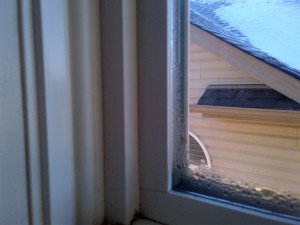
Typical condensation on bottom of window
The most common problem and most complained about problem I’ve seen in my 10+ years of completing new Home Warranty Inspections is condensation on the inside of the windows. You have a brand new house why do your windows have water on them? Is there a defect with the windows? Is there a problem with the installation? Are they just poor quality windows? Why does this only happen in the winter and not when it is raining? Should the builder be fixing this problem?

Condensation causing mold on bottom of window
The problem is related to humidity, temperature and ventilation. In nature warm air can hold more moisture vapour than cold air. The water vapour molecules are farther apart in warm air and not visible. Every house contains warm relatively moist air. In the winter, when the warm moist air comes in contact with the excessively cold surface of a window, the warm air drops the moisture on the cold glass surface of the window. The same thing happens when you take a cold drink out of the fridge and set it on the counter, condensation forms on the outside of the cold can.
Condensation will only happen when there is a high difference in temperature between inside and outside, and the humidity inside is excessive.
What is the maximum temperature difference and maximum humidity? Tarion (Ontario New Home Warranty) Construction Performance Guidelines Appendices has a table showing the suggested maximum inside relative humidity before you see condensation. For example, with double pane glass windows if the inside temperature is 20 degrees C and the outside temperature is -23 degree C then the maximum relative humidity recommended is 27%. But if the outside temperature is -7 degrees C then the maximum relative humidity recommended is 46%. That is a big difference.
How do you keep the humidity low enough during cold weather?
Follow these three stages:
Stage One
- Turn on the furnace fan to run continuously (ON position instead of AUTO).

Fan in “Auto” turn to “On”.
- Open all blinds, curtains, shutters, and move furniture away from floor registers to allow air flow to the window panes. If you have window screens on the inside of the windows remove those as well to encourage air flow past window pane.
- Run the “ventilation fan” which is the upstairs main bathroom fan (Second switch located by the thermostat).

After a few days these three steps will help move air past the windows helping temper the air and remove existing moisture from the windows. The exhaust fan will remove the warm moist air from the house thereby reducing the overall humidity in the house.
Stage 2
If the stage 1 steps are not working fast enough to reduce the humidity I would recommend you consider buying a dehumidifier (approx. $400). Some new home builders include dehumidifiers in the purchase of the home. Run the dehumidifier continuously in the basement with the drain line connected to a floor drain so no bucket needs to be emptied. You should get a device that measures the relative humidity in the house. These are readily available at hardware stores. The dehumidifier you own may already have relative humidity controls.
Stage 3
 If you think this is a lot of work and you want something easier then I recommend installing a HRV (Heat Recovery Ventilation) unit (approx. $2,000+).
If you think this is a lot of work and you want something easier then I recommend installing a HRV (Heat Recovery Ventilation) unit (approx. $2,000+).
This unit is installed in the furnace room and brings fresh air in to the house and at the same time removes moist stale air. Many new homes which are considered energy efficient have them installed by the builder already. Because they bring in fresh air and exhaust stale air they reduce the humidity in the house and at the same time improve your inside air quality.  The HRV is easy to operate with a central control near the thermostat. You can control the HRV by setting the humidity level by turning the dial to the desired level or run it continuously by flicking the bottom switch on the left side. The top switch on the left only controls the fan speed when it is in use (low or high).
The HRV is easy to operate with a central control near the thermostat. You can control the HRV by setting the humidity level by turning the dial to the desired level or run it continuously by flicking the bottom switch on the left side. The top switch on the left only controls the fan speed when it is in use (low or high).
Some HRV units have separate controls in bathrooms and kitchen to operate intermittently at those locations.
The quality of the window does have an impact. The better quality windows have less condensation because of better insulation and construction.




